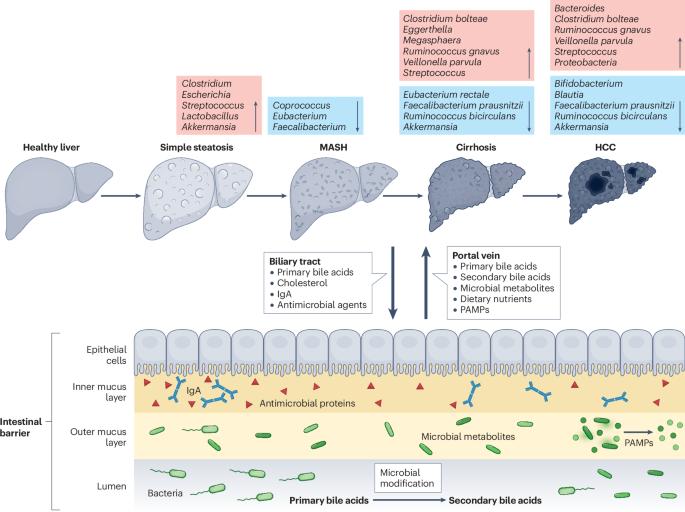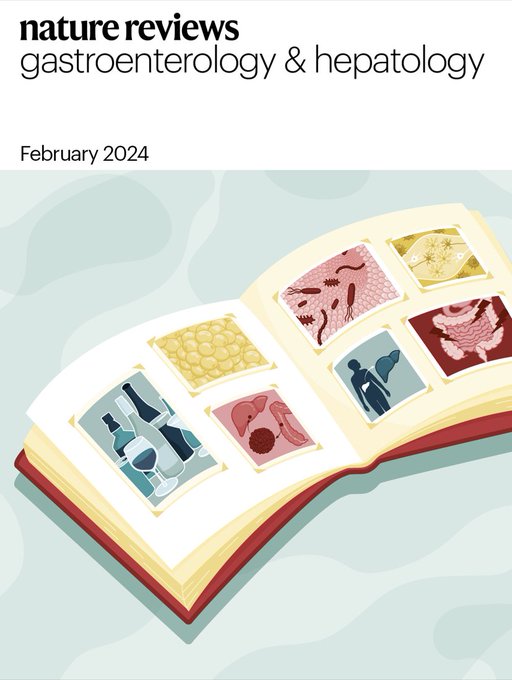Gut microbiome in metabolic dysfunction-associated steatotic liver disease and associated hepatocellular carcinoma
IF 51
1区 医学
Q1 GASTROENTEROLOGY & HEPATOLOGY
引用次数: 0
Abstract
Metabolic dysfunction-associated steatotic liver disease (MASLD) is the most prevalent chronic liver disease worldwide, affecting billions of the global population. It can gradually progress to more severe diseases, including steatohepatitis, cirrhosis and hepatocellular carcinoma. Studies have highlighted the importance of the gut microbiome in the pathogenesis and progression of MASLD. On the other hand, increasing evidence has revealed the clinical potential of targeting the gut microbiome to treat MASLD. In this Review, we summarize gut microbial alterations in MASLD, metabolic dysfunction-associated steatohepatitis and hepatocellular carcinoma. The mechanisms by which a dysregulated gut–liver axis contributes to disease progression are also described, including intestinal barrier dysfunction, chronic inflammation, and altered metabolic pathways (for example, bile acids) and microbial-derived metabolites (for example, short-chain fatty acids, tryptophan derivatives and endogenous ethanol). In addition, we discuss the clinical implications of utilizing the gut microbiome as a diagnostic biomarker and the therapeutic approaches to treat MASLD and related diseases such as faecal microbiota transplantation, probiotics and engineered bacteria, prebiotics and postbiotics, microbial-derived metabolites, antimicrobials and bacteriophages. Finally, we discuss current challenges in basic and translational research on the microbiome in MASLD and propose future directions to drive progress in this field. In this Review, Yu and colleagues describe the role of the gut microbiome and the gut–liver axis in metabolic dysfunction-associated steatotic liver disease (MASLD) and MASLD-related hepatocellular carcinoma (HCC). They discuss clinical implications for the diagnosis and treatment of MASLD and MASLD-related HCC.


代谢功能障碍相关脂肪变性肝病和相关肝细胞癌的肠道微生物组
代谢功能障碍相关脂肪变性肝病(MASLD)是全球最常见的慢性肝病,影响全球数十亿人口。它可以逐渐发展为更严重的疾病,包括脂肪性肝炎、肝硬化和肝细胞癌。研究强调了肠道微生物组在MASLD发病和进展中的重要性。另一方面,越来越多的证据揭示了靶向肠道微生物组治疗MASLD的临床潜力。在这篇综述中,我们总结了MASLD,代谢功能障碍相关的脂肪性肝炎和肝细胞癌的肠道微生物改变。还描述了失调的肠-肝轴导致疾病进展的机制,包括肠屏障功能障碍、慢性炎症和代谢途径(例如胆汁酸)和微生物衍生代谢物(例如短链脂肪酸、色氨酸衍生物和内源性乙醇)的改变。此外,我们还讨论了利用肠道微生物组作为诊断生物标志物的临床意义,以及治疗MASLD和相关疾病的治疗方法,如粪便微生物群移植、益生菌和工程菌、益生元和后益生菌、微生物衍生代谢物、抗菌剂和噬菌体。最后,我们讨论了目前MASLD微生物组基础和转化研究面临的挑战,并提出了推动该领域进展的未来方向。
本文章由计算机程序翻译,如有差异,请以英文原文为准。
求助全文
约1分钟内获得全文
求助全文
来源期刊
CiteScore
52.30
自引率
0.60%
发文量
147
审稿时长
6-12 weeks
期刊介绍:
Nature Reviews Gastroenterology & Hepatology aims to serve as the leading resource for Reviews and commentaries within the scientific and medical communities it caters to. The journal strives to maintain authority, accessibility, and clarity in its published articles, which are complemented by easily understandable figures, tables, and other display items. Dedicated to providing exceptional service to authors, referees, and readers, the editorial team works diligently to maximize the usefulness and impact of each publication.
The journal encompasses a wide range of content types, including Research Highlights, News & Views, Comments, Reviews, Perspectives, and Consensus Statements, all pertinent to gastroenterologists and hepatologists. With its broad scope, Nature Reviews Gastroenterology & Hepatology ensures that its articles reach a diverse audience, aiming for the widest possible dissemination of valuable information.
Nature Reviews Gastroenterology & Hepatology is part of the Nature Reviews portfolio of journals.

 求助内容:
求助内容: 应助结果提醒方式:
应助结果提醒方式:


